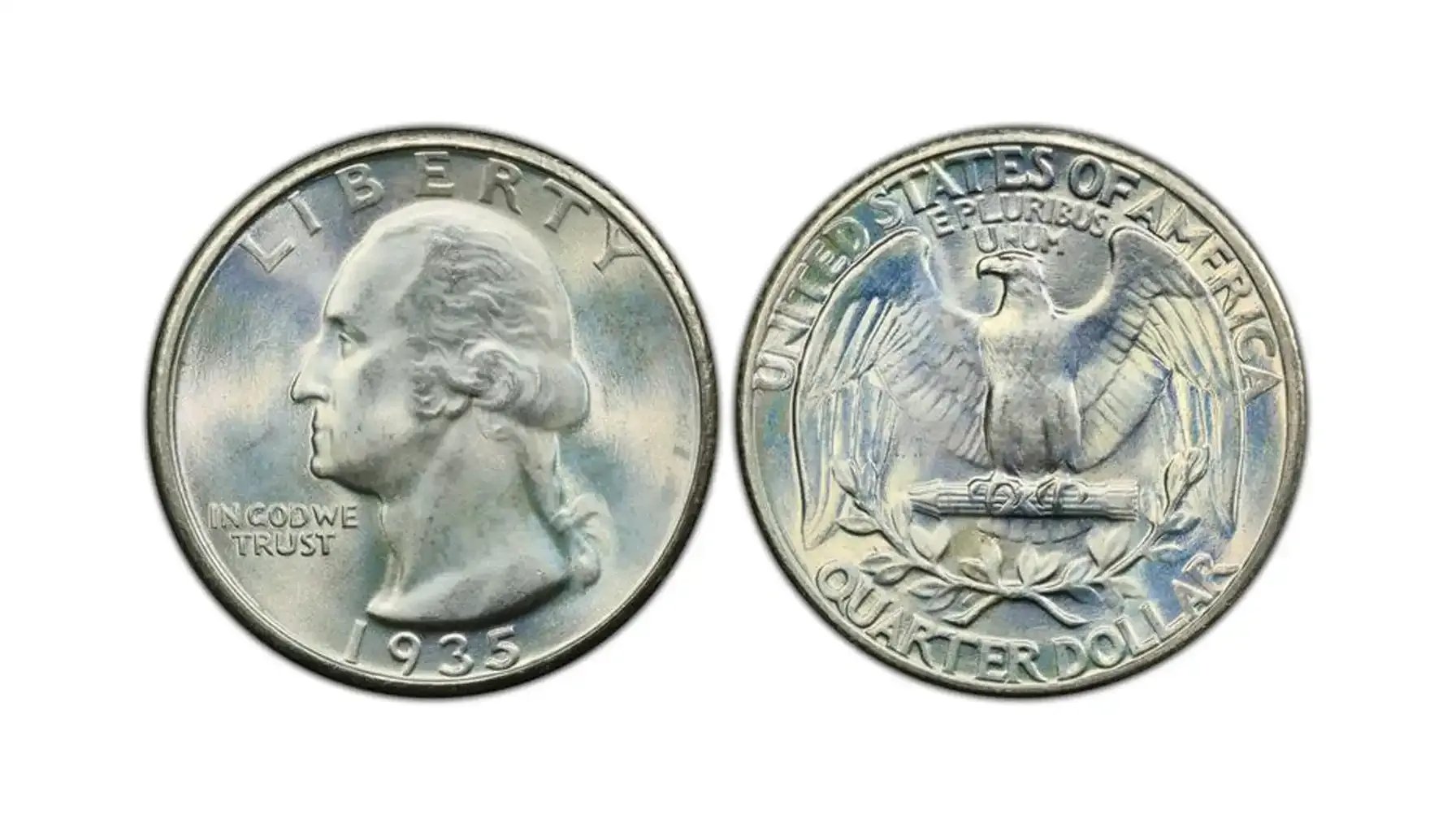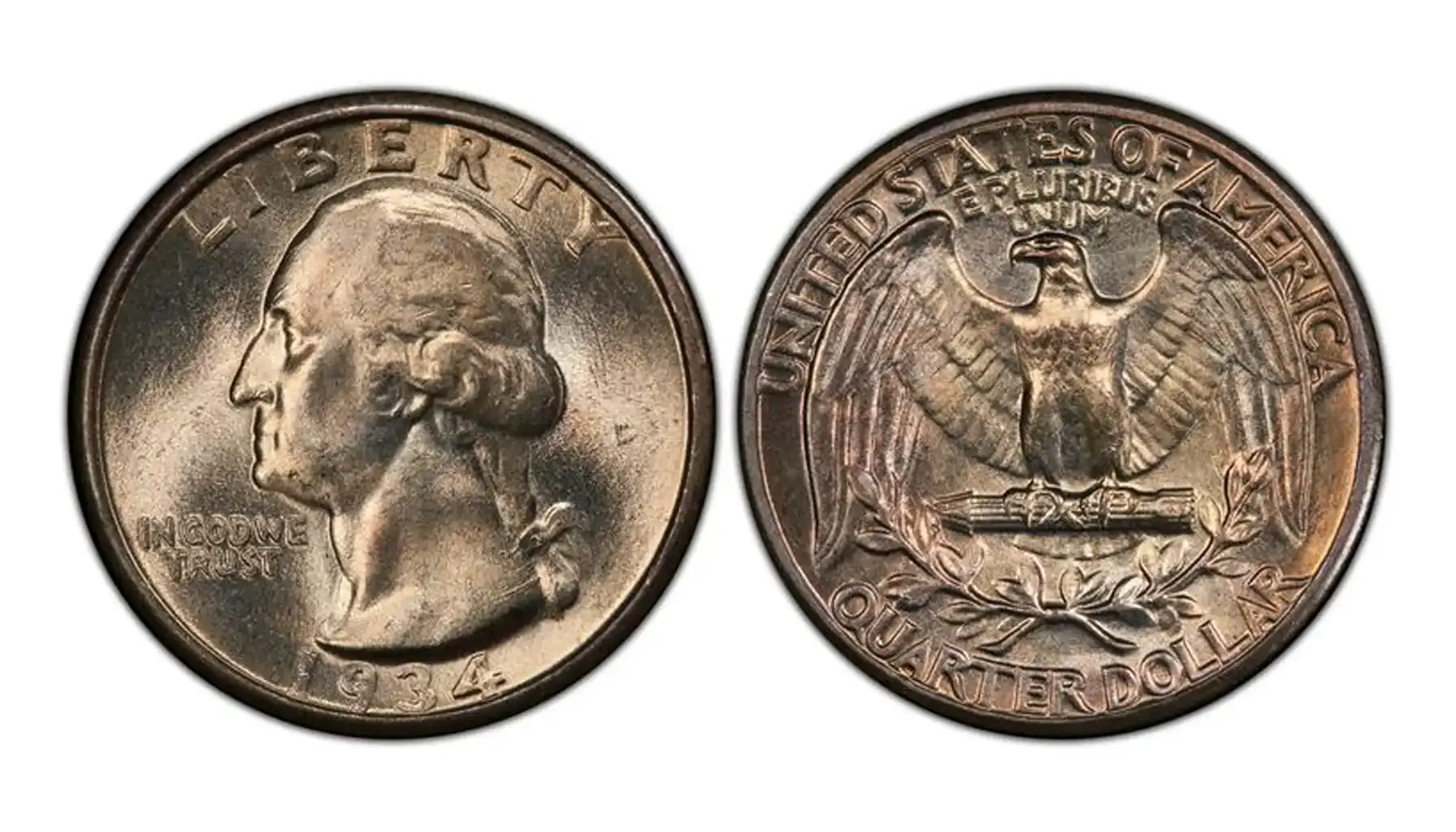Contents:
For many, the question "how much is a 1952 wheat penny worth" immediately comes to mind when encountering this classic coin. People determine the worth of this coin through a detailed examination of its individual characteristics.
The 1952 Wheat Penny Value Depends On Several Key Factors:
Rarity (Mintage & Survival Rate):
Mintage: How many coins were originally produced? Lower mintage figures often lead to higher rarity.
Survival Rate: Even if many were minted, how many still exist today? Coins from certain eras or those heavily used might have low survival rates in higher grades, making them rarer.
Condition (Grade):
Circulated vs. Uncirculated: Coins that have been used are "circulated" and show wear, which reduces their value. "Uncirculated" coins show no wear from circulation and retain their original mint luster. For those wondering how much is a 1952 D penny worth, uncirculated examples with strong strike are particularly desirable.
Professional Grading: For more valuable coins, independent free old coin value checker provide expert, unbiased assessment and encapsulation, which significantly boosts collector confidence and market value. Even common 1952 pennies are worth something, typically more than their face value, especially in higher grades
Mint Mark & Variety:
Mint Mark: Most U.S. coins have a small letter indicating where they were produced. Coins from different mints in the same year often have vastly different mintages and, therefore, different values.
Varieties & Errors: These are coins that deviate from the standard design due to a mistake in the minting process. If known and desirable, they can be exceptionally valuable.
1952 Wheat Penny Philadelphia (No Mint)
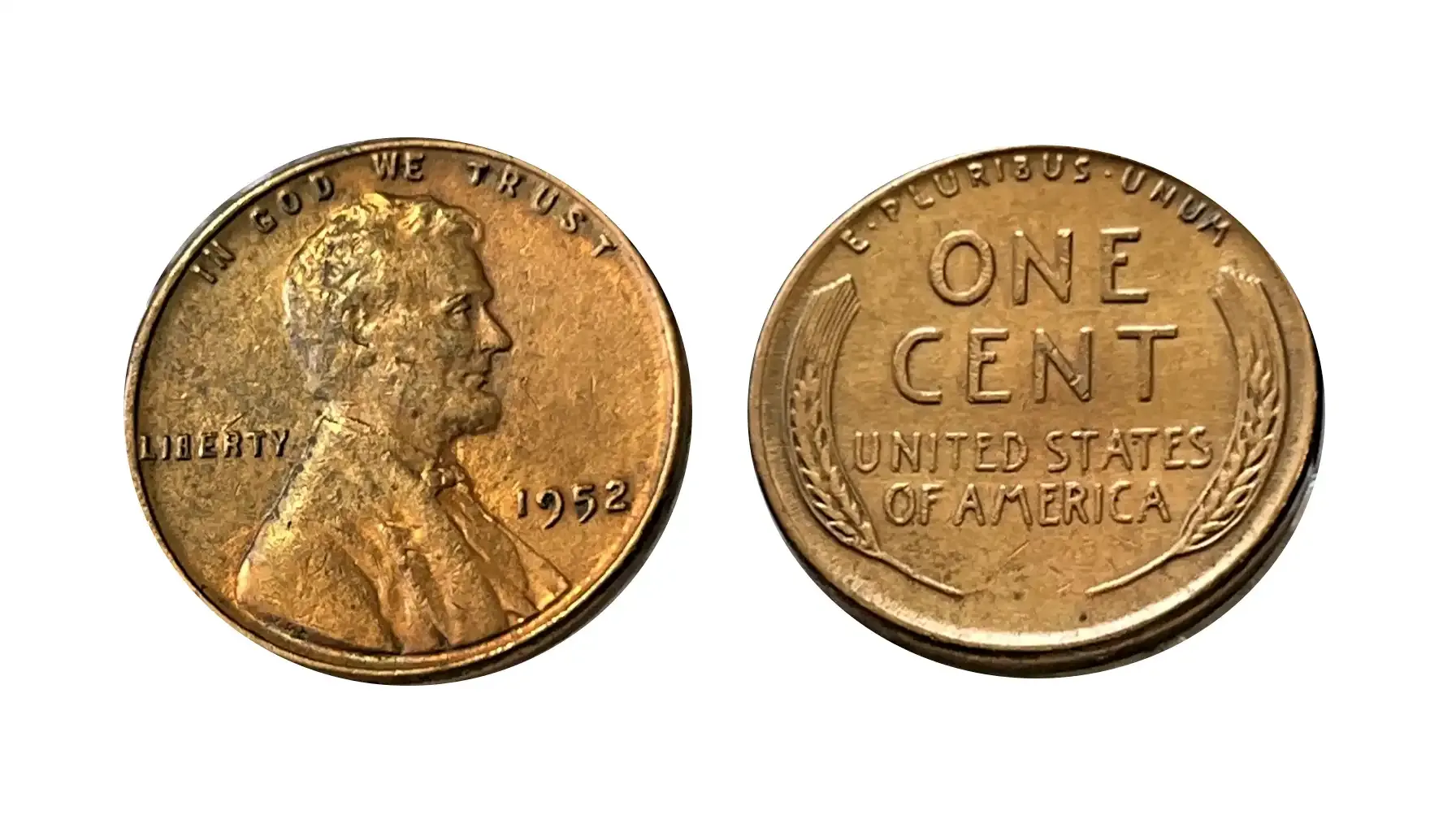
Name | 1952 Wheat Penny No Mint Mark |
Special Features | Features the classic Lincoln profile on the obverse and two wheat stalks on the reverse. The absence of a mint mark signifies it was produced at the Philadelphia Mint. |
Mintage | 186,725,000 |
Price | $0.20 - $60~ (depending on condition) |
Listed prices are approximate and may vary depending on the coin's condition, market demand, and other factors
Market Value
Grade | Price (USD) |
Good (G-4) | $0.20 - $0.50 |
Fine (F-12) | $0.50 - $1.00 |
VF (VF-20) | $1 - $2 |
AU (AU-58) | $3 - $5 |
MS (MS-63 RB) | $10 - $20 |
MS (MS-65 RD) | $30 - $60~ |
Historical Context
Several factors contribute to the overall 1952 penny value, including its mint mark and any unique varieties. The 1952 Wheat Penny no mint mark indicates it was produced at the Philadelphia Mint, which had a significant mintage. Produced in the post-World War II economic boom, these coins were widely circulated as the United States experienced rapid industrial growth and increased consumer spending.
The economy was robust, and demand for small denominations like the cent remained high. The value of a 1952 Wheat Penny can range from a few cents for circulated examples to potentially thousands for rare error coins or those in exceptionally high, uncirculated grades
1952-D Wheat Penny
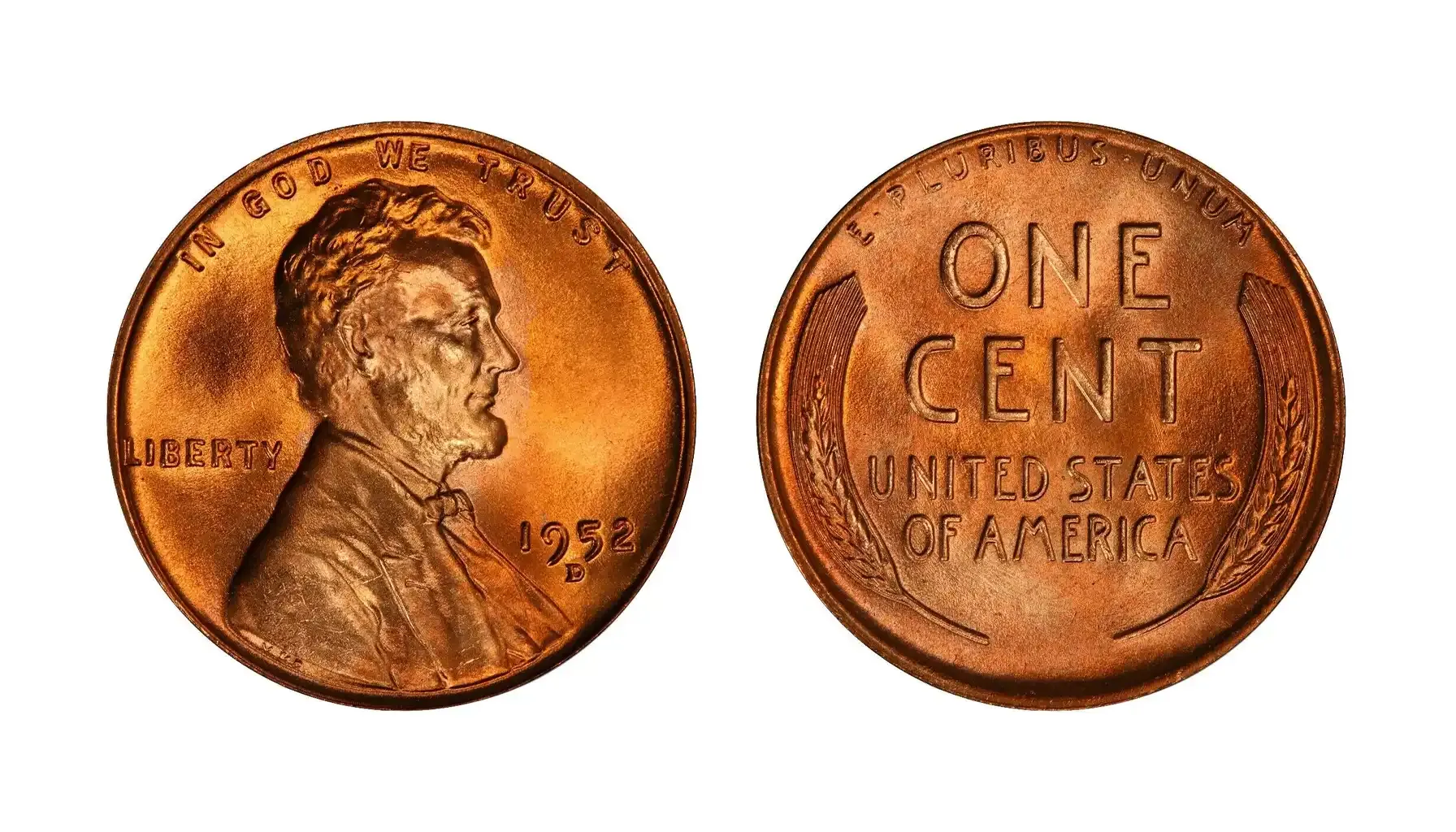
Name | 1952-D Wheat Penny |
Special Features | Struck at the Denver Mint, identified by the "D" mint mark below the date. Maintains the standard Lincoln obverse and wheat ears reverse design. |
Mintage | 508,310,000 |
Price | $0.20 - $50~ (depending on condition) |
Listed prices are approximate and may vary depending on the coin's condition, market demand, and other factors
Market Value
Grade | Price (USD) |
Good (G-4) | $0.20 - $0.50 |
Fine (F-12) | $0.50 - $1.00 |
VF (VF-20) | $1 - $2 |
AU (AU-58) | $3 - $5 |
MS (MS-63 RB) | $8 - $15 |
MS (MS-65 RD) | $25 - $50~ |
Historical Context
Determining the 1952 D penny value is influenced by its mintage figures and condition. The Denver Mint played a critical role in supplying coinage to the central and western United States, reflecting the continued population growth and economic activity in those regions.
Despite its high mintage, uncirculated examples with strong strike and full red color are still desirable. This coin facilitated countless transactions during the prosperous early 1950s, a period marked by post-war optimism and the early stages of the Cold War. A 1952 penny D, struck at the Denver Mint, has the highest mintage among the 1952 pennies
1952-S Wheat Penny
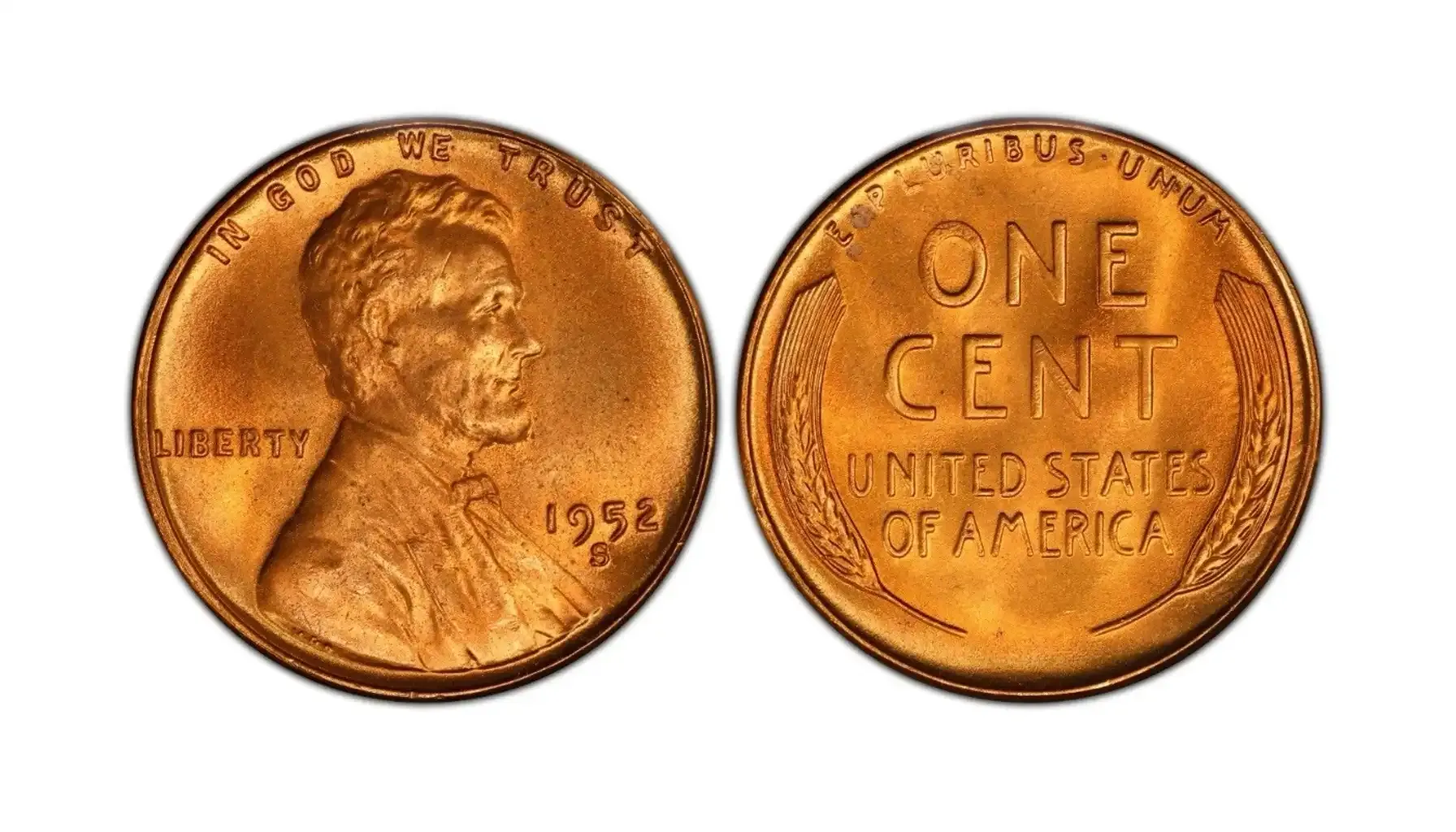
Name | 1952-S Wheat Penny |
Special Features | Produced at the San Francisco Mint, denoted by an "S" mint mark below the date. Features the familiar Lincoln portrait and wheat reverse. |
Mintage | 137,780,000 |
Price | $0.20 - $80~ (depending on condition) |
Listed prices are approximate and may vary depending on the coin's condition, market demand, and other factors
Market Value
Grade | Price (USD) |
Good (G-4) | $0.20 - $0.50 |
Fine (F-12) | $0.50 - $1.00 |
VF (VF-20) | $1 - $2 |
AU (AU-58) | $4 - $8 |
MS (MS-63 RB) | $15 - $30 |
MS (MS-65 RD) | $40 - $80~ |
Historical Context
The 1952 S Wheat Penny value tends to be slightly higher in top grades. The San Francisco Mint primarily served the Pacific Coast, an area experiencing dynamic growth. Coins from this mint often have a reputation for weaker strikes compared to Philadelphia or Denver, which can affect their grading and appeal.
The 1952 S penny value often reflects its lower mintage and the challenge of finding well-struck examples However, a well-struck 1952-S in high grade is a desirable coin for collectors aiming to complete their Wheat Penny sets.
1952 Wheat Penny DDO
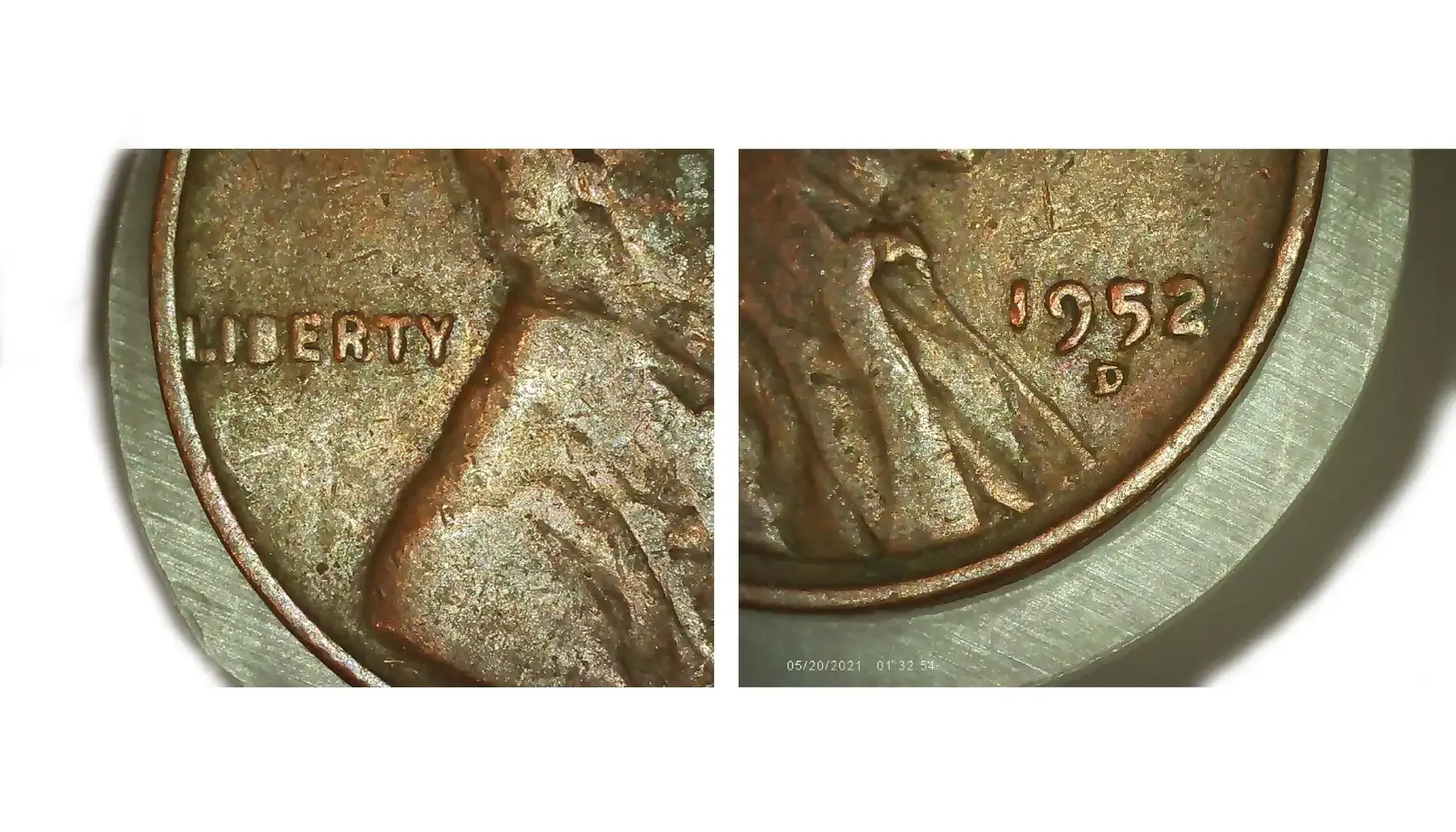
Name | 1952 Wheat Penny - Doubled Die Obverse |
Special Features | Exhibiting clear doubling of design elements on the obverse (front) of the coin, notably visible on the date, "LIBERTY," and "IN GOD WE TRUST." This results from multiple, slightly misaligned impressions from the master hub onto the working die. The 1952-D DDO is particularly well-known. |
Mintage | Extremely Low (Occasional finds, unique to specific dies; no official mintage) |
Price | $50 - $1,000s~ (Value depends heavily on the strength of doubling and coin grade) |
Listed prices are approximate and may vary depending on the coin's condition, market demand, and other factors
Market Value
Grade (Severity) | Price (USD) |
Circulated (Minor DDO) | $50 - $200 |
Circulated (Strong DDO) | $200 - $800 |
Uncirculated (Minor DDO) | $500 - $1,500 |
Uncirculated (Strong DDO) | $1,500 - $5,000~ |
Historical Context
The most well-known 1952 D Wheat Penny error is the Doubled Die Obverse, which significantly increases its worth. For the 1952 Wheat Penny, the 1952-D Doubled Die Obverse is a recognized variety that exhibits prominent doubling, especially on the date.
These errors occurred inadvertently during the manufacturing of the dies themselves, leading to a noticeable shift in the design when coins were struck. Since errors are not intentionally produced, their mintage figures are unknown, making each discovered example a unique anomaly. The rarity and visual appeal of a strong doubled die make it highly sought after, reflecting a moment of imperfection in the minting process that paradoxically creates perfection in the eyes of a collector.
1952 Wheat Penny - Off-Center Strike
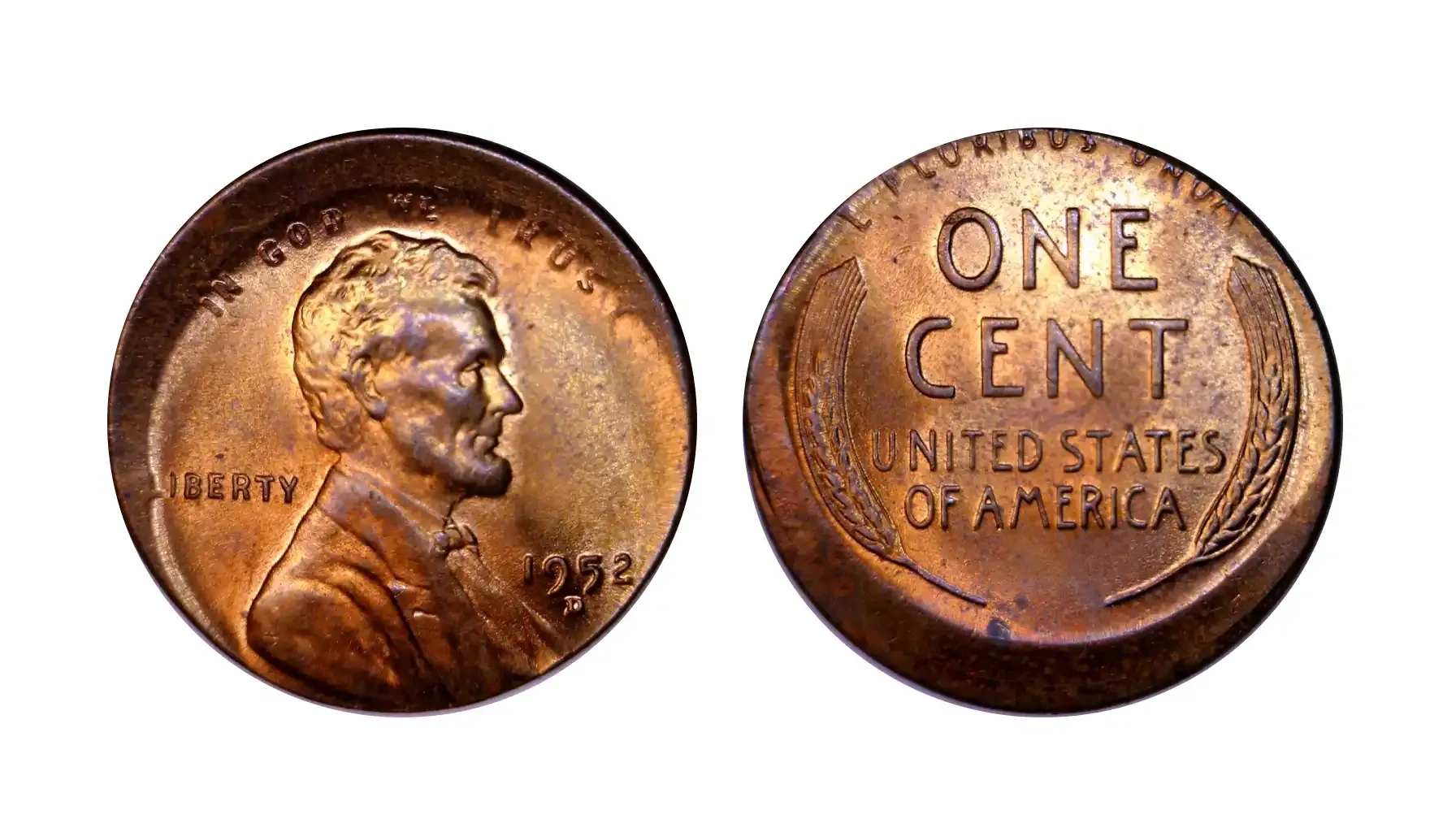
Name | 1952 Wheat Penny - Off-Center Strike |
Special Features | The coin's design is not centered on the planchet (coin blank), leaving a portion of the blank space visible on one side and cutting off part of the design on the opposite side. The degree to which it is off-center varies significantly. |
Mintage | Extremely Low (Occasional anomalies across all mints; no official record) |
Price | $20 - $500~ (Highly dependent on percentage off-center and whether the date is visible) |
Listed prices are approximate and may vary depending on the coin's condition, market demand, and other factors
Market Value
Degree Off-Center & Grade | Price (USD) |
Minor (1-5% off) | $20 - $75 |
Moderate (5-20% off) | $75 - $250 |
Significant (20-50% off) | $250 - $500~ |
Extreme (>50% off, date legible) | $500~ (if key features are visible) |
Historical Context
Off-center strike errors were more common in earlier minting operations, including the 1930s, due to less sophisticated feeding mechanisms in the coining presses. These errors occur when a coin blank is not correctly positioned within the collar before the dies strike it. The result is a coin where part of the design is missing and a crescent of blank metal is visible. For a 1935 Lincoln Penny, an off-center strike provides a direct glimpse into the mechanical challenges faced by the mints striving to produce millions of coins daily under considerable pressure. The value of such an error is primarily determined by the degree of the off-center strike and whether key identifying features like the date and mint mark remain legible, making them unique relics of the coin production process during the Depression era.
1952 Wheat Penny - Die Crack
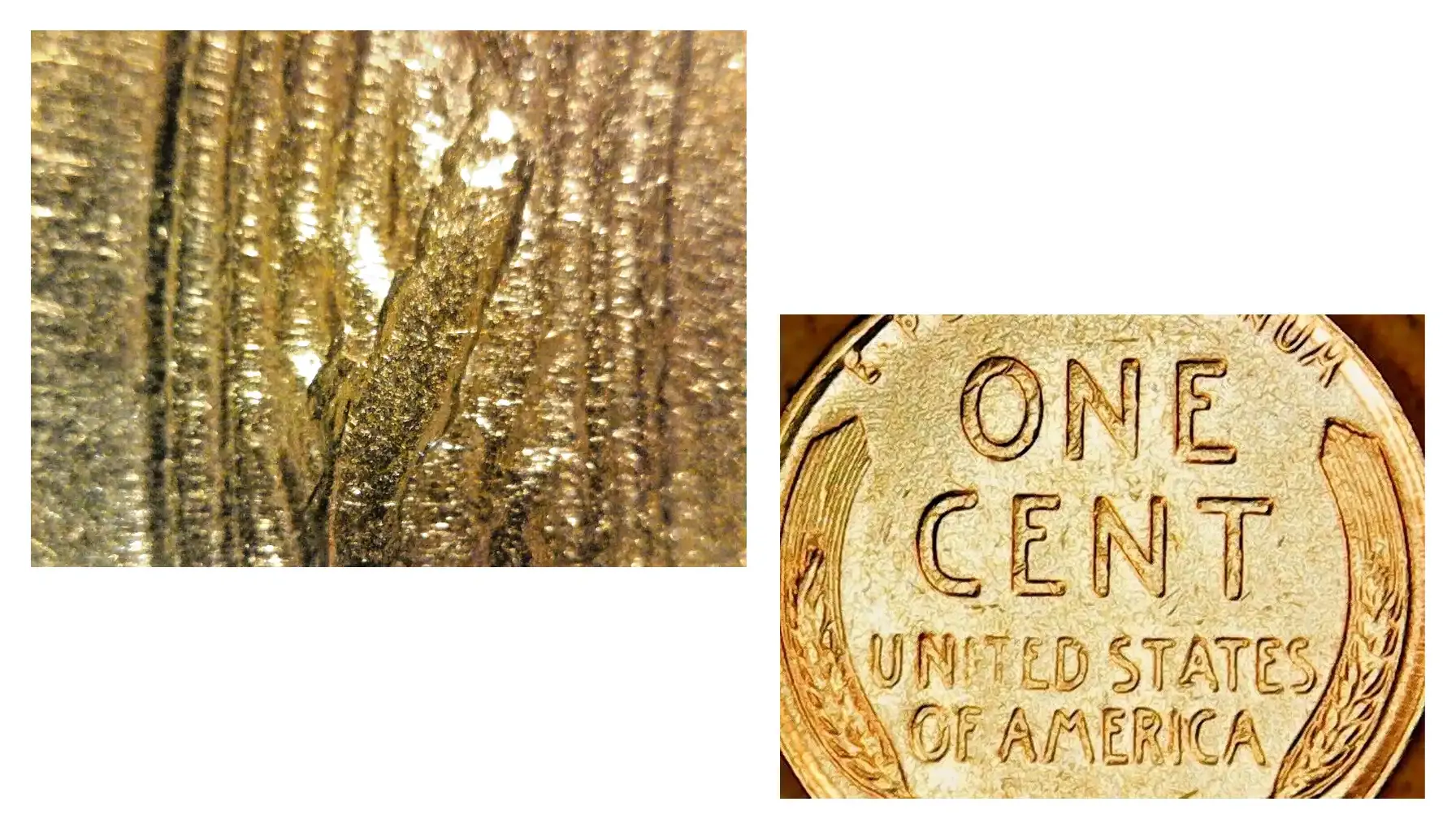
Name | 1952 Wheat Penny - Die Break |
Special Features | Manifests as raised lines or lumps on the coin's surface, mirroring a crack or a piece of the die that has broken off. These can range from faint lines (die cracks) to large, raised areas (cuds) where a significant portion of the die's edge or field has fractured and separated |
Mintage | Extremely Low (Accidental and sporadic; mintage figures are unknown, as they represent production anomalies) |
Price | $10 - $500~ (Value is highly dependent on the visibility, size, location, and overall visual impact of the die break) |
Listed prices are approximate and may vary depending on the coin's condition, market demand, and other factors
Market Value
Degree Off-Center & Grade | Price (USD) |
Minor Die Crack (Circulated) | $10 - $30 |
Significant Die Crack (Circulated) | $30 - $100 |
Minor Die Break (Uncirculated) | $50 - $200~ |
Major Die Break (Cud - Uncirculated) | $200 - $500~ |
Extensive Die Break / Complex Cud | $500 - $1,500~ |
Historical Context
Die breaks are a natural consequence of the intense and repetitive pressure involved in striking millions of coins. As the steel dies used in the coining press repeatedly strike coin blanks, they endure immense stress, leading to microscopic fissures that can eventually grow into visible cracks or even cause pieces of the die to break off. For the 1952 Wheat Penny, produced in high volumes across three mints, the likelihood of dies cracking was significant.
In conclusion, when evaluating a 1952 one cent penny, the question "what is a 1952 penny worth" hinges on several factors. For instance, the 1952-D wheat penny worth varies based on its condition and specific characteristics. Collectors often wonder "is a 1952 wheat penny worth anything" significant, and the answer is yes, particularly for uncirculated examples or those with a verifiable 1952 penny error. Both a 1952 penny error and a 1952 wheat penny error, like the Doubled Die Obverse or an off-center strike, can dramatically increase its numismatic value.


